Crispy pan-fried cod tongues are a favourite here in Newfoundland. They can be enjoyed as an appetizer or as a main dish with a side. The cod tongues are simply seasoned, lightly dredged in flour and pan fried. Easy and delicious!
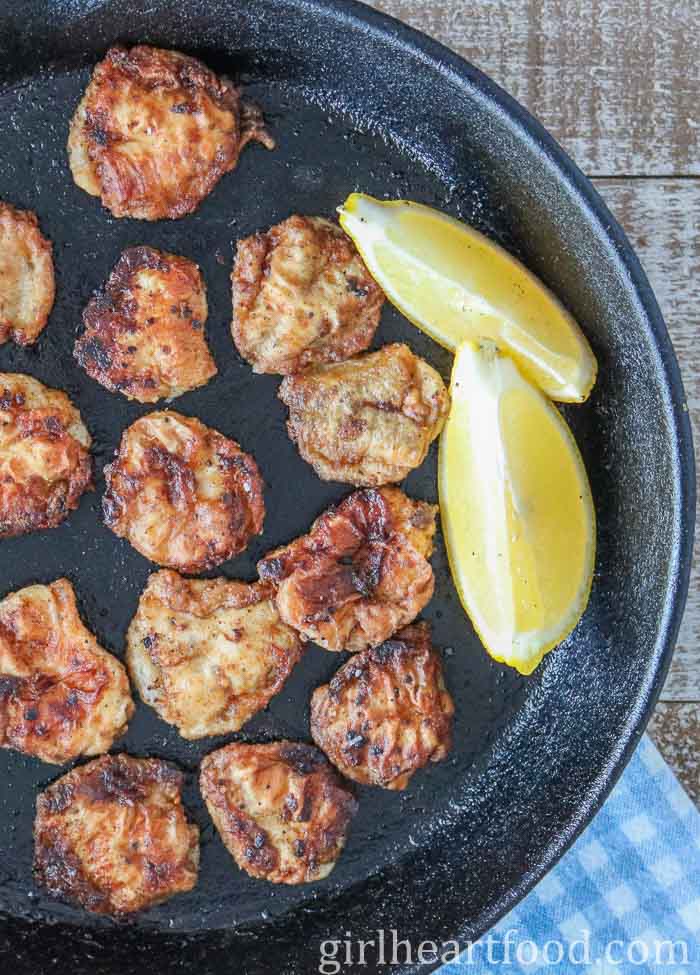
Yes, you read the recipe title correctly. This is a recipe for cod tongues.
If you’re from Newfoundland, this is more than likely not odd for you.
If you’re not from Newfoundland, you may be a little perplexed. But, please stay with me here. They’re really yummy! Think of them as little cod nuggets; essentially, nuggets seasoned well, dredged in flour and pan fried. They’re crispy, golden brown and so scrumptious.
You see, pan-fried cod tongues are a favourite here in Newfoundland. As you may have heard me say before, Newfoundland has a deep rooted history in the cod fishery. We have all sorts of recipes for cod in these parts, all unique and delicious.
What I particularly love about the concept of this recipe is that it uses a part of the fish that may often get overlooked. It’s using something aside from the most commonly used parts, like the fillets.
One random Saturday, hubby and I went to see my parents. It turned out to be an impromptu visit on a lovely sunny day and we ended up staying and enjoying a casual dinner of steamed mussels and, you guessed it, crispy fried cod tongues.
As dad was cooking, I watched closely, carefully taking note of everything he was doing and asking questions. I thought, it would be a great idea to share another popular recipe from where I’m from. So, suffice to say, I’m excited to be sharing this recipe with you all today!
Fan of seafood? Try this cod au gratin recipe!
What Are Cod Tongues?
The cod tongue is actually a muscle in the cod fish neck, but they’re commonly referred to as the former.
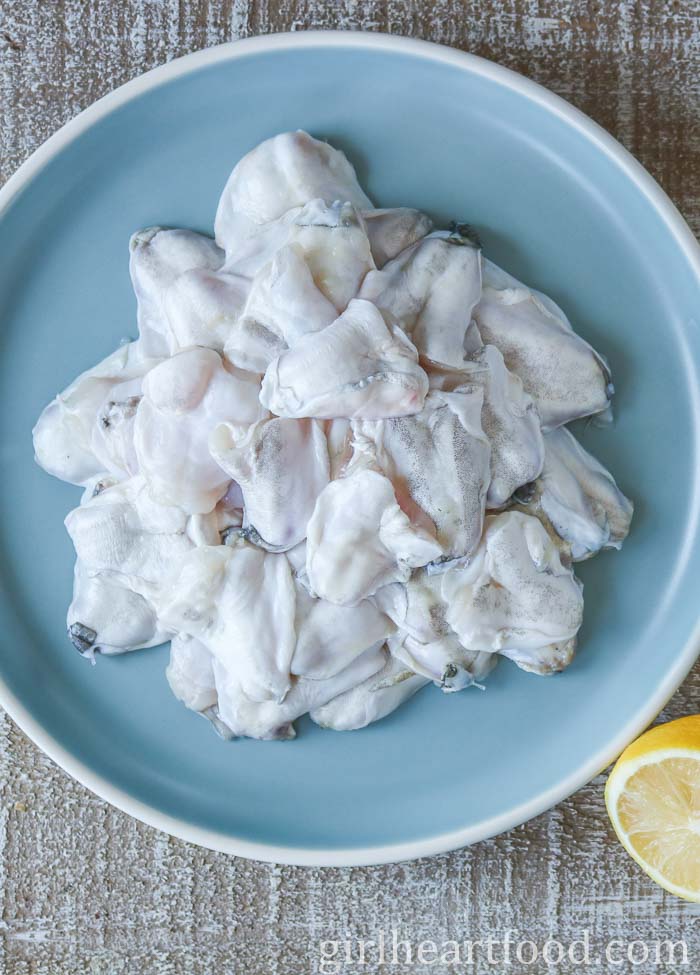
What Do They Taste Like?
If you put it out of your head that it’s a tongue or neck muscle, it’s actually quite delicious. They’re meatier and denser than, say, the flesh or the type of meat you would get from a fillet.
What Size Should I Look For?
I prefer smaller cod tongues. I tend to find the larger ones more fatty and have somewhat of a jelly consistency in areas. Some people go for that, though.
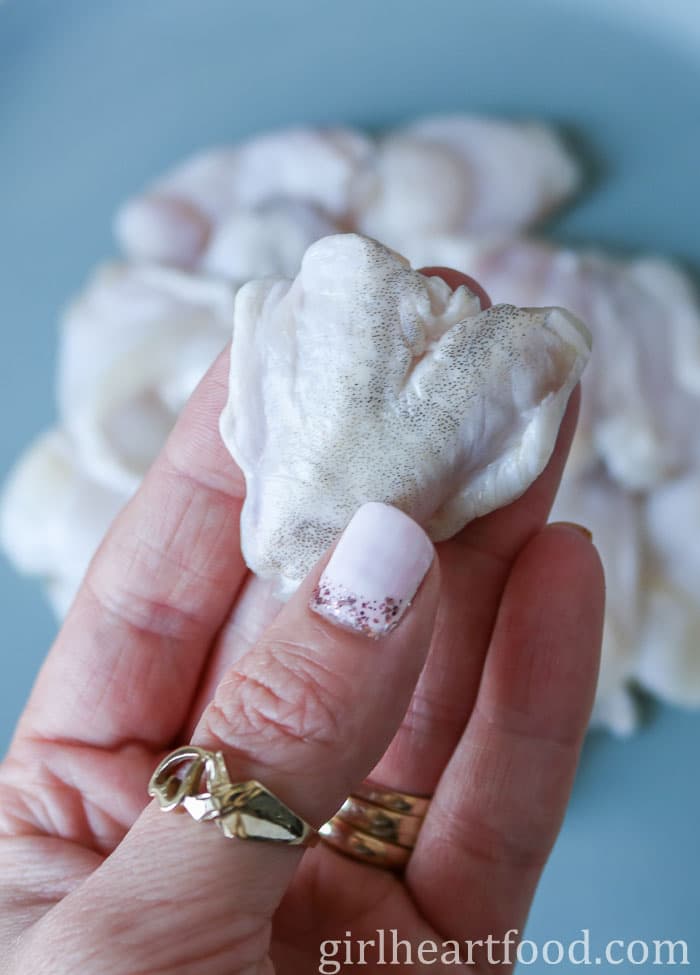
How Many Do I Need?
I used about 1 pound in this recipe. The actual quantity that makes up that pound can vary, depending on their size.
Since I opted for those on the smaller size, my pound comprised about 35 to 40 pieces. However, on average, there would be roughly 30 tongues in a pound.
Bottom line: Allow for 6 to 8 cod tongues per person for an appetizer. If enjoying as a main, you may want a couple more, plus a side dish.
Ingredients Needed for This Recipe
- Cod tongues (of course)
- All-purpose flour
- Seasoning: I used lemon pepper seasoning blend, salt, paprika and ground cayenne pepper.
- Cooking oil
Tip
Traditionally, people often fry cod tongues in rendered pork fat. I prefer to use vegetable oil or olive oil. And, as for seasoning, just salt and black pepper is more traditional. I like to use salt, a lemon pepper seasoning blend, paprika and a bit of ground cayenne pepper because that’s what dad used. Feel free to go the more traditional route if that’s what you prefer!
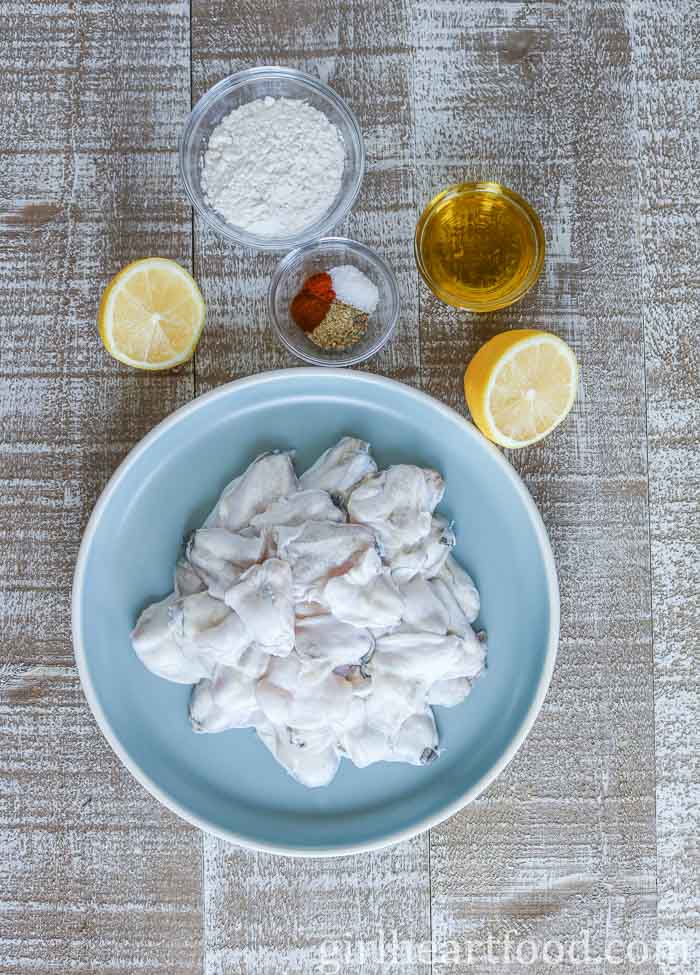
How To Make This Cod Tongue Recipe
Full details are in the recipe card below, but here are the basics:
- Give the tongues a little wash under fresh, cold water. Drain and pat dry with paper towels.
- Place them in a bowl and add the lemon pepper seasoning blend, salt, paprika and cayenne pepper. Coat the cod tongues well. Note: Again, most times (and more traditionally), you’ll find cod tongues seasoned with just salt and black pepper. The extra seasoning adds something special.
- Place some flour in a bowl and dredge each cod tongue all over in the flour, shaking off the excess. Dad’s tip is to dredge one a time. However, in a pinch (or if you’re making a big batch), you could place half of the cod tongues in a food-safe plastic bag, add flour, and shake to coat. Repeat with the other half. Place the flour-dredged cod tongues on a plate as you are coating them.
- Heat some olive oil or vegetable oil in a skillet. Add some cod tongues to the skillet and cook on one side, then carefully flip each cod tongue and cook on the other side. Once they’re cooked, transfer them to a serving plate. If you like, you can give the them another sprinkling of salt while they’re hot. Cod tongues are delicious enjoyed with a squeeze of lemon and tartar sauce.
Note: Cook the cod tongues in batches, replacing the oil, as necessary, between batches.
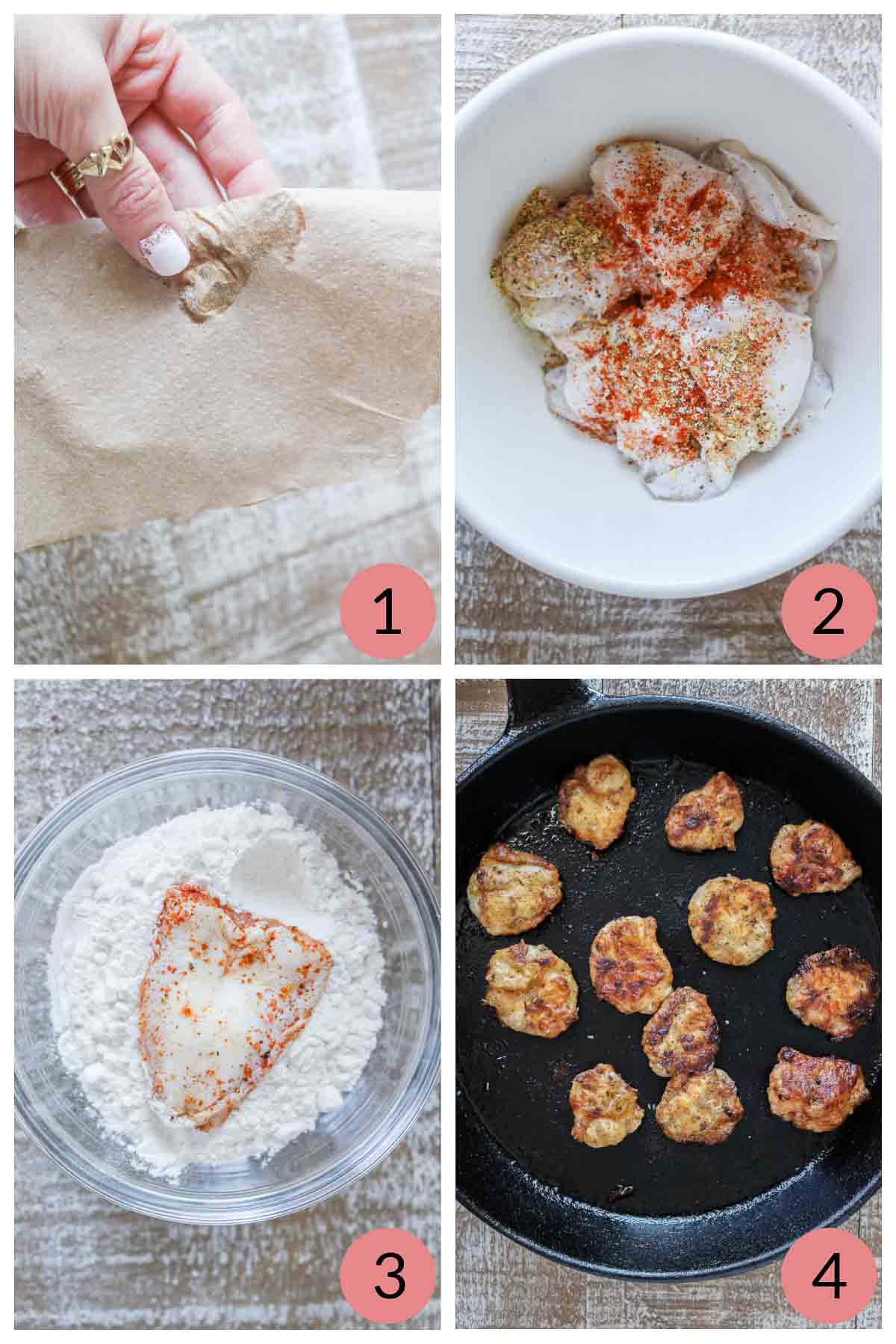
Can I Make These Ahead of Time?
This recipe comes together super quickly and are best enjoyed as soon as they are made while they are fresh and crispy.
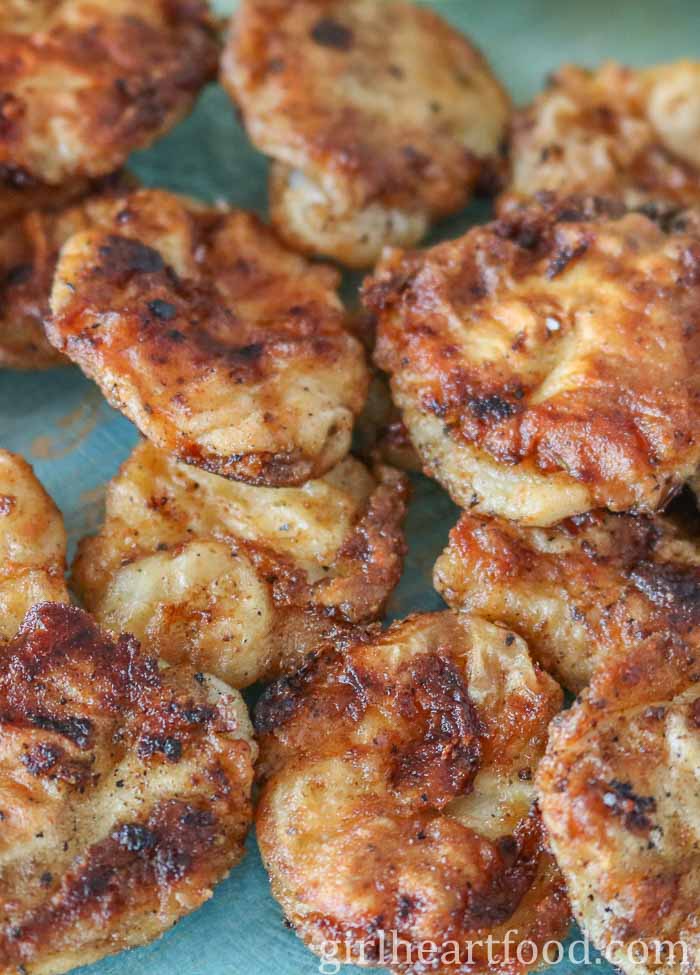
What To Serve With Cod Tongues
As mentioned above, I love to serve cod tongues with some fresh lemon and tartar sauce for dipping.
You can certainly enjoy them as they are, but if you are making things more of a meal enjoy them with:
- Green salad
- Mashed potatoes or oven roasted potatoes
- French fries
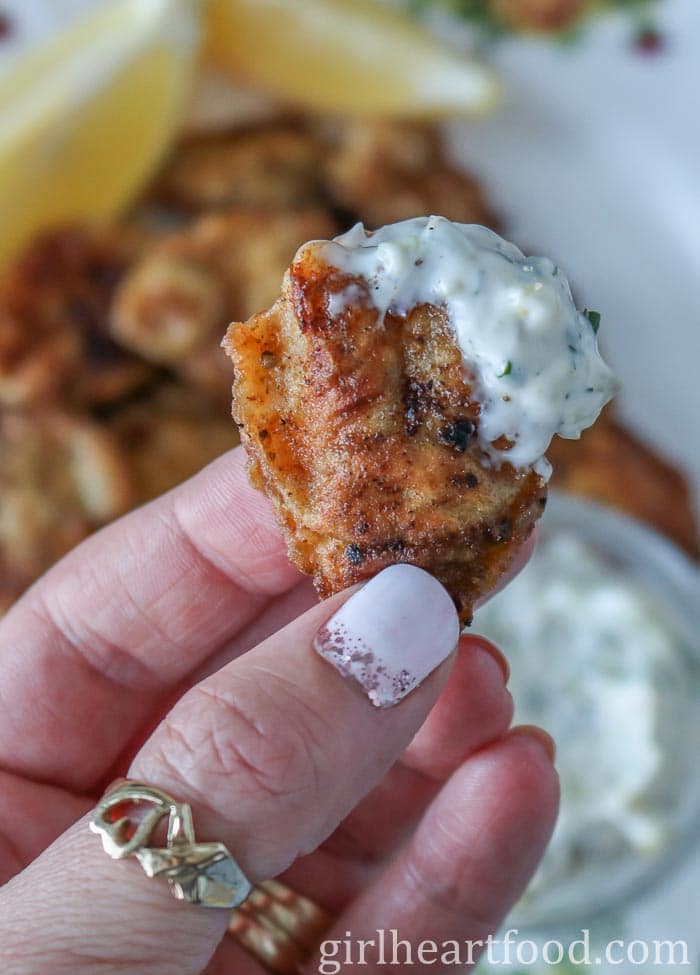
More Yummy Recipes You May Enjoy
If you make this recipe for pan-fried cod tongues, be sure to leave a comment below!
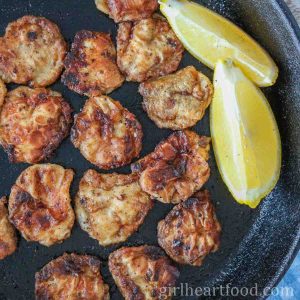
Pan-Fried Cod Tongues (A Newfoundland Favourite!)
Ingredients
- 1 pound cod tongues, about 35 to 40 small cod tongues (see "Notes," Point "2" below)
- 2 teaspoons lemon pepper seasoning blend
- 1 teaspoon paprika
- 1 teaspoon salt
- ¼ to ½ teaspoon ground cayenne pepper, optional
- ¼ cup all-purpose flour
- 2 to 3 tablespoons olive oil or vegetable oil, approximately (to fry cod tongues)
- Lemon wedges, for serving (optional)
- Tartar sauce, for serving (optional)
Instructions
- Wash cod tongues with some cold water and pat dry with paper towels.
- Place cod tongues in a bowl (or food-safe plastic bag) and sprinkle the lemon pepper seasoning blend, paprika, salt and ground cayenne pepper (if using) over top. Seal bag and gently shake to coat the cod tongues in the seasoning.
- Dredge cod tongues in flour and coat all over (can do one at a time or place the flour in a bowl or food-safe plastic bag and do multiple at a time).
- To cook cod tongues, heat olive oil or vegetable oil (about 2 teaspoons per batch) in a 12-inch cast-iron skillet over medium heat. Note: Cook the cod tongues in batches (you'll have about 2 to 3 batches) and don't overcrowd the pan. Add more oil between batches as necessary.
- When oil is hot, add cod tongues, about 12 cod tongues per batch. Cook for 5 minutes on one side.
- Flip cod tongues to the other side and continue to cook for another 5 minutes or until cod tongues are cooked through.
- Transfer cooked cod tongues to a plate (you can then sprinkle with a little more salt, if you like).
- Repeat process to cook remaining cod tongues.
- After they've all cooked, transfer the cod tongues to a serving platter.
- Serve with lemon wedges and tartar sauce (optional, but yummy). Makes 4 appetizer servings or can be enjoyed as a main with a side.
Notes
- Cook time is about 10 minutes per batch (or until cooked through). Total cook time of 30 minutes is based on doing 3 batches, each at 10 minutes.
- I used one pound in total of small cod tongues. The number of tongues in a pound could vary, if the ones you use are larger. Since I opted for those on the smaller size, my pound was about 35 to 40 pieces. However, on average, there would be roughly 30 tongues in a pound.
- Don’t have lemon pepper seasoning? You could use just salt and black pepper, along with paprika and cayenne or simply salt and black pepper (which is more traditional for pan-fried cod tongues). Alternatively, just use your favourite seasoning blend.
- If you opt to use regular black pepper instead of the lemon pepper seasoning blend, use a little less. Typically, I find that a half teaspoon or so of black pepper works for me. If you’d like to add more, go for it!
A note on times provided: appliances vary, any prep and/or cook times provided are estimates only.
© Girl Heart Food Inc. Photographs and content are copyright protected.
Tried this recipe?
If you do make this recipe, thank you!! It would mean so much if you could leave a comment below. Love to know how you enjoyed it, and it helps other readers too!

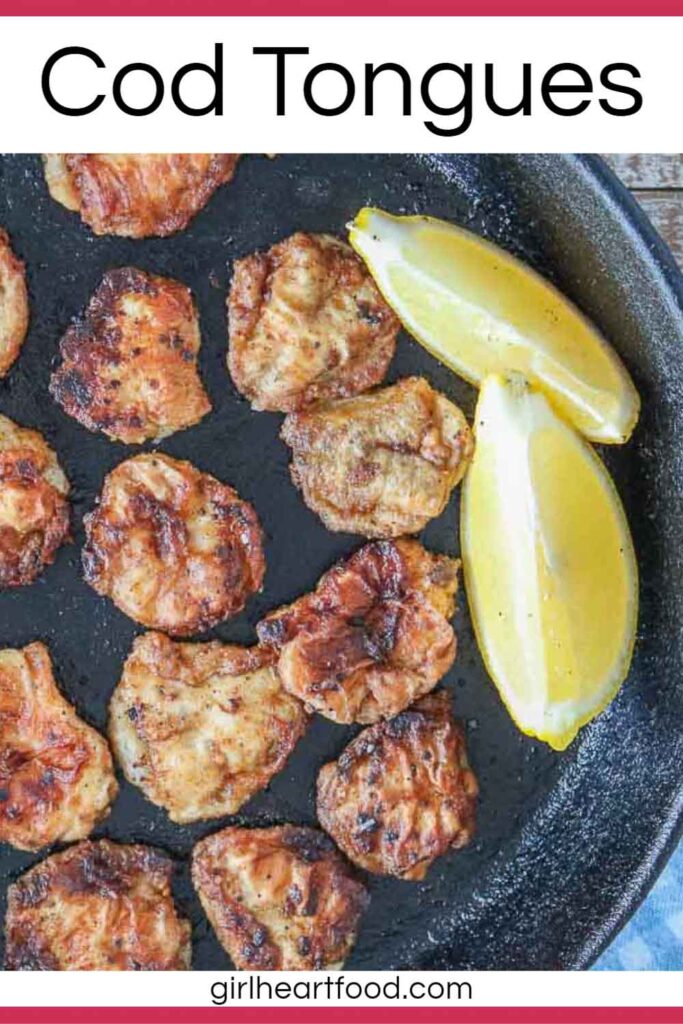




Jess says
Delicious! I seasoned them with chilli, cayenne, paprika, black pepper and lemon zest..doused in flour and fried in olive oil.. yummy!! Thank you for the recipe. I get them in my Fishbox from Scotland but have never really known what to do with them!
Dawn | Girl Heart Food says
Thank you very much, Jess! I’m so glad that you enjoyed it!
Kelly | Foodtasia says
Dawn, they look so crispy and beautifully golden brown! Yes, I was perplexed – all sorts of things running through my mind! I thought it might be a nice, safe filet with a fancy preparation. I would definitely try it! I wouldn’t mind if somebody slipped me one and told me what it was after I ate it 🙂 Love your Newfoundland recipes. NF is definitely on my wish list of places I’d love to visit!
Dawn - Girl Heart Food says
Thank you Kelly! That makes me so happy to hear that 🙂
Marissa says
Whoa, my bold and beautiful friend! I’ve heard of halibut cheeks, but cod tongues are new to me. I am game to try them, they look totally delicious!
Dawn - Girl Heart Food says
Lol! Thank you Marissa! I bet you’d love ’em 🙂
Paul Johnson says
Smaller cod tongues are much better I find than larger ones. And I’m cooking up a batch of them tonight. And if you want to try something else, ask Dawn if she has a recipe for cod cheeks. I know, something else sounding strange. But Dawn can give you some great directions for them.
Heidi | The Frugal Girls says
I’ve never tried Cod Tongues, but now I need to. These look DELICIOUS!
Dawn - Girl Heart Food says
Thank you very much, Heidi!!
Laura says
Dawn, what an interesting recipe! I love when you post traditional Newfoundland dishes. I have to admit, every time, the song “I’m a Newfoundlander!” From the awesome musical “Come from Away” goes through my head! But I digress, these look delicious! I may have to ask the fishmonger if they have cod tongues!
Dawn - Girl Heart Food says
Thank you so very much, Laura! Love to hear that 🙂